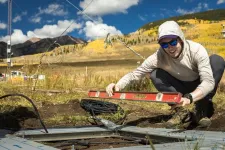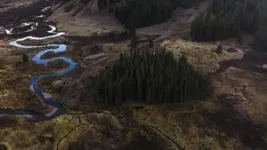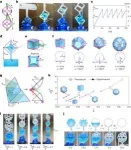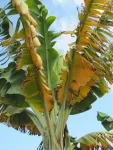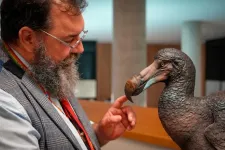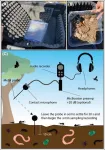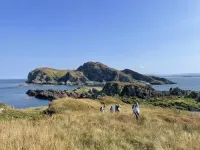(Press-News.org) The Colorado River and its tributaries provide water for hydropower, irrigation and drinking water in seven U.S. states and Mexico. Much of this water comes from the snowpack that builds up over the winter and then melts each spring. Every year in early April, water managers use the snowpack to predict how much water will be available for the upcoming year.
But since 2000, these predictions have been incorrect, with the actual streamflow being consistently lower than the predicted streamflow. That’s left water managers and researchers flummoxed — where's the water going?
The problem lies with the lack of rainfall in the spring, according to new research from the University of Washington. The researchers found that recent warmer, drier springs account for almost 70% of the discrepancy. With less rain, the plants in the area rely more on the snowmelt for water, leaving less water to make its way into the nearby streams. Decreased rain also means sunny skies, which encourages plant growth and water evaporation from the soil.
The researchers published these results Aug. 16 in Geophysical Research Letters.
"The period of time when we were wondering, 'Oh no, where's our water going?' started around the same time when we saw this drop in spring precipitation — the beginning of the 'Millennium drought,' which started in 2000 and has been ongoing to the current day," said lead author Daniel Hogan, a UW doctoral student in the civil and environmental engineering department. "We wanted to focus on the cascading consequences of this. Less springtime rain means you likely have fewer clouds. And if it's going to be sunny, the plants are going to say, 'Oh, I'm so happy. The snow just melted and I have a ton of water, so I'm going to grow like gangbusters.' This research really centers the importance of studying the whole snow season, not just when the snowpack is the deepest."
Hogan and senior author Jessica Lundquist, a UW professor of civil and environmental engineering, studied this phenomenon as part of a bigger project to solve the big "whodunit" of where the water is going. At first, the researchers wondered if the snowpack was decreasing because the snow was simply turning into water vapor — a process called sublimation. But the team recently discovered that only 10% of the missing water was lost due to sublimation, meaning something else was the main culprit.
"There are only so many possible culprits, so I started to compare things that might be important," Hogan said. "And we saw that springtime changes are a lot more exaggerated than they are in other seasons. It's this really dramatic shift where you're going from feet of snowpack to wildflowers blooming over a very short amount of time, relatively speaking. And without spring rains, the plants — from wildflowers to trees — are like giant straws, all drawing on the snowpack."
The researchers looked at springtime changes in 26 headwater basins at various elevations in the Upper Colorado River Basin. To paint a picture of what was happening at each basin over time, the team used a variety of datasets, including streamflow and precipitation measurements dating back to 1964. The researchers then modeled how much water the plants at each basin would likely consume.
"We make an important assumption in the paper," Hogan said. "We assume that the plants have an unlimited amount of water even with less-than-average precipitation, because they have access to snowmelt."
All the basins the team studied showed reduced streamflow without springtime rain. But basins at lower elevations had an even more pronounced deficit in streamflow. This is because the snow at these basins is likely to melt earlier in the season, giving the plants more time to grow and consume the snowmelt, the researchers said.
Now that spring rain has been identified as the main culprit, the researchers are working to further refine their understanding of what's happening during this season. For example, one project is investigating whether residual patches of snow are acting as mini-reservoirs that can provide a constant stream of water to nearby plants.
Regardless, the longer the Millennium drought continues, the more these results will affect the water calculations that happen each April.
"April is when everybody wants to know how much water is in the snowpack each year," Lundquist said. "But the problem with doing these calculations in April is that obviously spring hasn't occurred yet. Now that we know spring rain is actually more important than rain any other times of the year, we're going to have to get better at predicting what's going to happen rainwise to make these April predictions more accurate."
This research was funded by the National Science Foundation, the Sublimation of Snow Project and the Department of Energy Environmental System Science Division (the Seasonal Cycles Unravel Mysteries of Missing Mountain Water project).
END
Why isn't Colorado's snowpack ending up in the Colorado River? New research suggests the problem might be the lack of spring rainfall
2024-08-16
ELSE PRESS RELEASES FROM THIS DATE:
New research shows unprecedented atmospheric changes during May's geomagnetic superstorm
2024-08-16
On May 11, a gorgeous aurora surprised stargazers across the southern United States. That same weekend, a tractor guided by GPS missed its mark.
What do the visibility of the northern lights have in common with compromised farming equipment in the Midwest?
A uniquely powerful geomagnetic storm, according to two newly published papers co-authored by Virginia Tech's Scott England.
“The northern lights are caused by energetic, charged particles hitting our upper atmosphere, which are impacted by numerous factors in space, including the sun,” said England, associate professor in the Kevin T. Crofton Department of Aerospace and Ocean Engineering. “During ...
How some states help residents avoid costly debt during hard times
2024-08-16
COLUMBUS, Ohio – A new national study provides the best evidence to date that generous unemployment insurance benefits during the COVID-19 pandemic helped reduce reliance on high-cost credit use.
Researchers found that lower-income residents of states with more generous benefits were significantly less likely than those living in less-generous states to take out new credit cards, personal finance loans and payday loans or other alternative financial service offerings.
The study, published recently in the journal ...
Same person. Different place. Twice the odds of a dementia diagnosis.
2024-08-16
With new medications on the market or in the works for Alzheimer’s disease and other kinds of dementia, a new study suggests that getting the diagnosis needed to access these new treatments may depend on where you live.
The percentage of people who get a new dementia diagnosis each year varies a lot across regions of the U.S., the study finds.
And the differences between regions of the country are even larger for people on the young end of the dementia-risk age range, ages 66 to 74, and for those who are Black ...
The banana apocalypse is near, but UMass Amherst biologists might have found a key to their survival
2024-08-16
August 16, 2024
The Banana Apocalypse is Near, but UMass Amherst Biologists Might Have Found a Key to Their Survival
Discovery of molecular mechanisms used by the banana-destroying microbe brings hope to the breakfast table
AMHERST, Mass. – The bananas in your supermarket and that you eat for breakfast are facing functional extinction due to the disease Fusarium wilt of banana (FWB) caused by a fungal pathogen called Fusarium oxysporum f.sp. cubense (Foc) tropical race 4 (TR4). However, thanks to recent research from an ...
Rethinking the dodo
2024-08-16
Rethinking the Dodo
Review of 400 years of scientific literature corrects the record on icon of extinction
Researchers are setting out to challenge our misconceptions about the Dodo, one of the most well-known but poorly understood species of bird.
In a paper published today [16 August 2024] in the Zoological Journal of the Linnean Society researchers from the University of Southampton, Natural History Museum (NHM) and Oxford University Museum of Natural History have undertaken the most comprehensive review of the taxonomy of the Dodo and its closest relative, the Rodriguez ...
Arts and crafts improves your mental health as much as having a job, scientists find
2024-08-16
Could arts and crafts help protect the public’s mental health? A new study in Frontiers in Public Health provides evidence that indulging our creative side could provide everyone with a significant wellbeing boost. Because arts and crafts are relatively affordable and accessible, promoting the public’s access to artistic activities could provide a major boost to public mental health.
“Crafting and other artistic activities showed a meaningful effect in predicting people’s ...
It’s a rave – underground acoustics amplify soil health
2024-08-16
Barely audible to human ears, healthy soils produce a cacophony of sounds in many forms – a bit like an underground rave concert of bubble pops and clicks.
Special recordings made by Flinders University ecologists in Australia show this chaotic mixture of soundscapes can be a measure of the diversity of tiny living animals in the soil, which create sounds as they move and interact with their environment.
With 75% of the world’s soils degraded, the future of the teeming community of living species that live underground face a dire future without restoration, says microbial ecologist Dr Jake Robinson, from the Frontiers ...
New poll finds 50% of parents believe too much time on technology hinders kids from forming connections in the classroom
2024-08-16
COLUMBUS, Ohio (August 16, 2024) – Building positive connections with teachers and peers in the classroom can be critical to the mental health and academic success of children and adolescents. Yet, a new national poll from The Kids Mental Health Foundation, conducted by Ipsos, finds half of parents believe spending too much time on technology and social media hinder children from making meaningful connections as they head into the upcoming school year.
The poll, conducted by Ipsos on behalf of ...
How policing impacts the homeless
2024-08-16
People who are homeless often endure constant and intrusive police interactions, leaving them feeling intimidated, harassed and stigmatised, a new study finds.
More people of all ages and backgrounds are finding themselves homeless, often due to job loss or illness, as well as a lack of affordable housing. Between 2016 and 2021 homelessness increased by 5.2% in Australia.
Professor of Law Thalia Anthony from the University of Technology Sydney (UTS) said the research aimed to give a voice to people experiencing homelessness ...
Scottish and Irish rocks confirmed as rare record of ‘snowball Earth’
2024-08-16
A rock formation spanning Ireland and Scotland may be the world’s most complete record of “snowball Earth”, a crucial moment in planetary history when the globe was covered in ice, finds a new study led by UCL (University College London) researchers.
The study, published in the Journal of the Geological Society of London, found that the Port Askaig Formation, composed of layers of rock up to 1.1km thick, was likely laid down between 662 to 720 million years ago during the Sturtian glaciation – the first of two global freezes thought to have ...
